What we can learn from living out loud with ALS
An Alaskan cruise with friends serves as a reminder to live intentionally
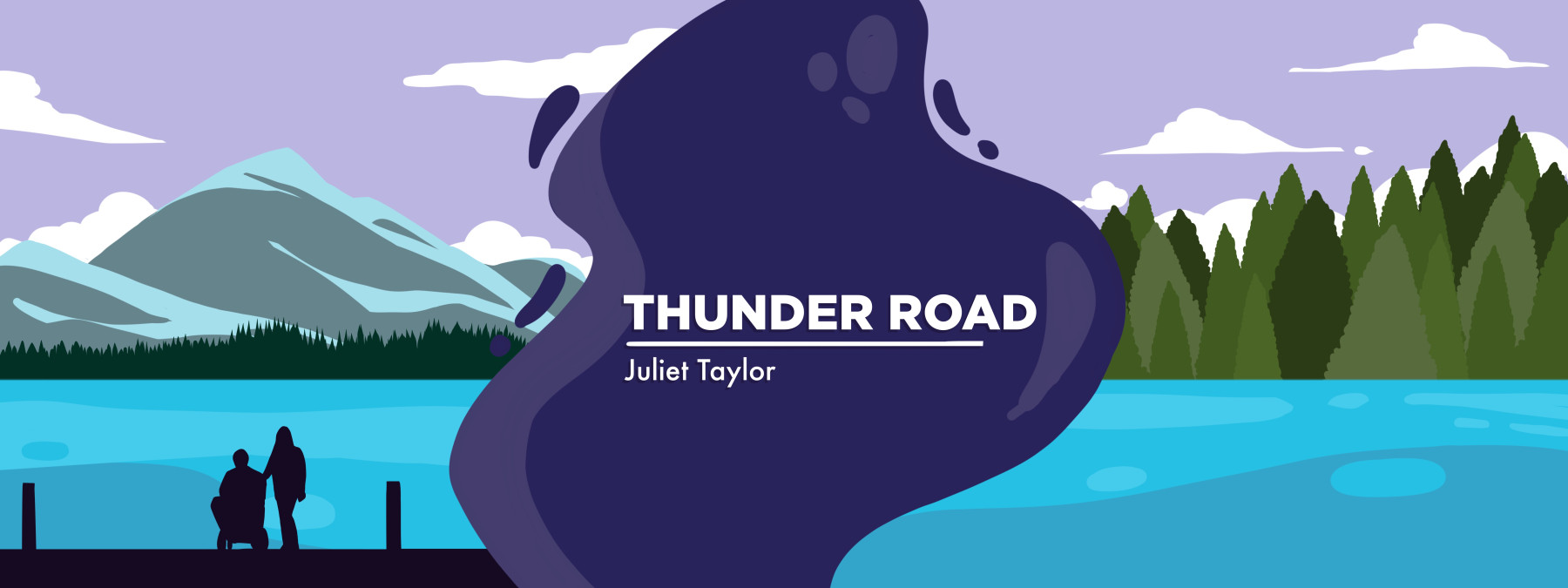
I’m writing this column while gazing out over a foggy Pacific Ocean, aboard a ship that’s taking a group of us from Vancouver, British Columbia, Canada, to the icy waters of Glacier Bay, Alaska, and back. Intermittently on this voyage, pods of porpoises come racing close by the ship, and humpback whales surface to exhale 6-foot plumes of breath into the air before diving again, showing their shimmering tail flukes as they do.
Because we’ve been close to the shore, we also saw a mother grizzly bear and her two playful cubs ambling along a rocky beach near the spectacular Margerie Glacier. This trip has renewed my sense of wonder about the natural world. It’s also inspired, once again, my sense of what’s possible in life, even amid challenges.

A sunset over Alaska’s Inside Passage, as seen from a cruise ship in August 2024. (Photo by Juliet Taylor)
When I travel, I’m always carrying memories of my late husband, Jeff, who died from ALS in 2020. Jeff was curious about the world, and his journeys for both business and pleasure took him to Japan, Australia, many countries in Europe, and the Caribbean. So it wasn’t surprising that after his ALS diagnosis, Jeff wanted simply and fervently to live.
He didn’t mean, at the time, that he wanted to physically survive ALS, although we both wanted that desperately. What he meant was that he wanted to create and embrace moments, have experiences, try new things, and savor already-known favorite things. He wanted to spend time with the people he loved and, in doing so, create new memories for all of us. And so, with great intention, he did.
Jeff’s time living with ALS was too brief, just 19 months from diagnosis until he died. But in those months, he took a gondola to the top of a mountain, rafted down a gentle Canadian river, and traveled the full length of the University of Michigan football field in light snow. He drove powerboats, went to bars with his buddies from the Bureau of Alcohol, Tobacco, Firearms, and Explosives, and went deep-sea fishing. For all of these adventures, he was using his wheelchair. He lived voraciously and vigorously.
Focusing on what we can do
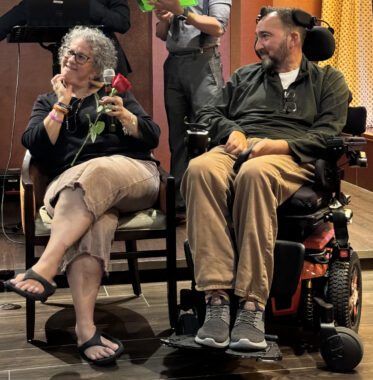
Juan and Meg Reyes share about their relationship during a cruise ship activity in Alaska in August 2024. (Photo by Juliet Taylor)
I’ve been thinking about Jeff a lot on this Alaska cruise because I’m traveling with a small group that includes my beloved friends Juan and Meg Reyes. Juan was diagnosed with ALS in 2015 and has been using a wheelchair full time since 2017. Each summer, Juan and Meg, who were high school sweethearts who’ve now been together for 40 years, travel the country in their recreational vehicle, Big Blue, visiting friends and members of the ALS community while blogging about it.
I love Juan for his ability to deliver the best one-liners (exclaiming, “Oh look, a dolphin,” when dinner conversation turns to politics), for his quiet powers of observation, and for the way he lights up when he talks about his kids. I love hearing the stories and perspective he gained from working as an Air Force medic in nearly every region of the world, delivering first-line primary and trauma care to hundreds of deployed troops. I love Meg, who’s never met a stranger, for her innate warmth, candor, and commitment to making sure she and Juan embrace every moment of life.
And it’s true, too, that I see some of Jeff’s resolve in Juan and Meg, and it makes me grateful that they share their experiences and talents with the world. Juan, for example, is on the board at I AM ALS and regularly mentors others living with the condition, both those newly diagnosed and further progressed.
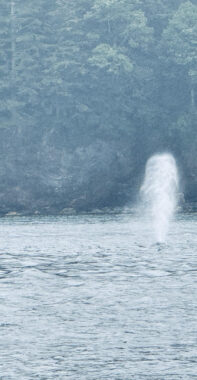
A humpback whale spouts on the surface of Alaska’s Inside Passage. (Photo by Juliet Taylor)
So much of ALS is frustration, fear, and limitation. Jeff’s ALS was the single most frightening thing I’ve ever experienced, by orders of magnitude over anything else. Building awareness, educating others, and living with hope and intention are the only things many of us nonscientists can do to fight back. I think that’s a big part of why Juan and Meg have emerged as leaders in the ALS community. They show by example and compassion and heart how it’s possible to live well with ALS, helping others as they do.
I told Juan this week that I notice how he focuses on what he can do rather than on what he physically cannot. He nodded emphatically. On this ship, there’s been far more that he can do, and I suspect that he finds those opportunities more often than not. Jeff was the same — he couldn’t walk, but he could mow the lawn. He couldn’t speak, but he could tell me he loved me every day.
I’ll never make light of the losses that ALS brings. It’s relentless and painful and humbling each and every time our loved ones lose any ability. We defeat ALS every time we choose to focus on what we can do, and then do it while we can.
To follow Juan and Meg’s journey, please visit their website.
Note: ALS News Today is strictly a news and information website about the disease. It does not provide medical advice, diagnosis, or treatment. This content is not intended to be a substitute for professional medical advice, diagnosis, or treatment. Always seek the advice of your physician or other qualified health provider with any questions you may have regarding a medical condition. Never disregard professional medical advice or delay in seeking it because of something you have read on this website. The opinions expressed in this column are not those of ALS News Today or its parent company, Bionews, and are intended to spark discussion about issues pertaining to ALS.





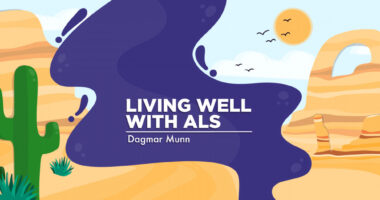
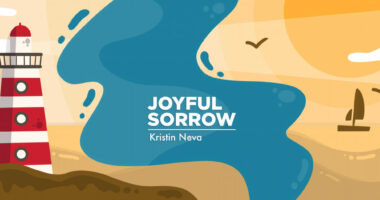
RAY S LEININGER
I love to here of people that do not surrender to the diase,but push to do everything they can I was diagnosed with Als on May 20th 2016 . That was the one I excepted.from Dr. Zachery Simmons of Penn State/Hershey. It started in 2015 being a 100% disabled veteran.I used the VA as my health care. the neurologist there started out thinking I had a stoke,then told me the good news was I didn't have a stroke,but the bad news was they didn't know what was wrong.so she explained it to me as the testing and stuff I had no knowledge of. broke it down like I. have four horses in the race.could be parsnicks turnner {not sure I am spelling correctly } ,m s ,some other neuro muscular disease or Als. after a few months of all these testing I dove into the computer.and started with the worst. ALS as I. was reading through the testing I realized what was happening. they were eliminating each diases one at a time.and when the couldn't pin it on any of the lesser diases it was then the worst ALS no treatment no cure .as I said earlier I would not except the VA neurologist diagnosis.So I searched for the best in the field.I found Dr.Zachery Simmons.Who happened to be at Penn State /Hershey.after another 6 months of test same result.I had to except! He told me to get my things in order that the average person would be in a wheelchair in 6months to a year.that within 2-3 years on a breathing or feeding tube and most die within 3-5 years.Well I couldn't except that I was a warrior! I served in the Navy and the Army. I was very muscular.I would not give in. I Would not Surrender! it's been 8years and I get around 75 % of the time with my braces and a forearm crutch.I. use a up right walker for something's and the full power wheelchair they gave me 7 and 1/2 years ago only when I have to go long distance..like with my 4 year old granddaughter taking her to an amusement park or things of such. I signed my living will and my dnr's I don't want a breathing tube or feeding tube. I fully believe that I have made it this far is my belief in being a warrior of God and country .of course I have progressed and it a lot of pain with all the trama my body went through for 50 years before.mussel compensates for everything.And fighting a neuro muscular diases isn't easy. but I still keep pushing! bless you all